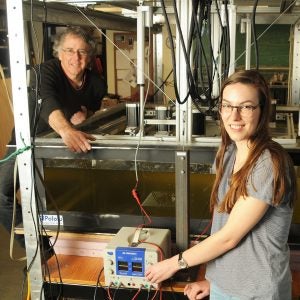Posted on March 20, 2018 at URI Today
NARRAGANSETT, R.I.—March 20, 2018—Corn syrup gets a bad rap from nutritionists for adding on the pounds, but University of Rhode Island researchers are using the gooey stuff to help solve Earth’s evolution.

Loes van Dam, a student in the Graduate School of Oceanography, is studying how molten rock flows beneath ocean ridges to get a better idea of how Earth evolved geologically.
Molten rock is hard to come by these days so van Dam is relying on corn syrup—lots of it—to simulate these flows. Scientist and syrup are collaborating thanks to the newly-built Ridge Zone Replicator, or RZR, on URI’s Bay Campus.
“Corn syrup behaves similarly to molten rock,” says van Dam. “Its flow in laboratory minutes resembles molten rock’s flow over millions of years in the real world.”
ABC 6 News Video [themify_icon icon=”fa-play-circle” link=”http://www.abc6.com/story/37832602/uri-researchers-using-corn-syrup-to-study-plate-tectonics” icon_color=”#ff0000″ style=”large”]
NBC 10 News Video [themify_icon icon=”fa-play-circle” link=”http://turnto10.com/news/local/uri-students-using-2000-pound-vat-of-corn-syrup-to-model-earths-mantle” icon_color=”#ff0000″ style=”large”]
The apparatus was built last summer by the 23-year-old van Dam and Christopher Kincaid, an oceanographer at GSO renowned for his research on Earth’s fluid circulation, from the coastal ocean to the planet’s interior.
The apparatus in Kincaid’s “Viscous Geophysical Fluid Dynamics Laboratory” holds three full barrels of syrup, or about 165 gallons.
It might be hard to top 2,000 pounds of the glucose, but consider the tectonic plates. Loes built a plate simulator using six polyurethane belts, each driven by a motor capable of pulling a car. With the flick of a switch, the apparatus hums to life, moving the corn syrup based on the characteristics of a particular mid-ocean ridge van Dam and Kincaid want to model.
“We find interesting features in the flow patterns, depending on the speed and directions of the plate motion, and the different ridge geometries,” she says. “The flows from linear ridge sections look much more simple than the flows from more jagged ridge sections.”
Kincaid says that, to his knowledge, Loes is the first researcher to simulate how the syrup responds to the complete range of plate motions observed at mid-ocean ridges. Up until now, computer simulations have struggled with representing the wandering of the ridges.
The team uses high-resolution cameras to photograph the flow, which can then be processed to generate 3-D data. Their results help geochemists and geophysicists study the breakup of tectonic plates, as well the formation of new crust on the seafloor.
Mid-ocean ridges are long lines of volcanoes on the seafloor where Earth’s tectonic plates are spreading apart and new seafloor is being made. There are about 50,000 miles of such ridges on the ocean bottom. Van Dam studies the way that molten rock under these ridges flows in response to the tectonic plates shifting above.
“Our research on these flows tells us something about volcanic activity at mid-ocean ridges and the way the seafloor looks in these places. In the process, we’re learning about how the Earth evolves.”
So far, the team has found from its simulations that the source region of the magma is different from what scientists have always assumed.
“The complex nature of plate motion makes it difficult to model, but our results are promising,” says van Dam. “We hope we’ll be able to solve some big questions about where magma forms and how it ends up as new seafloor.”
Born in The Netherlands, van Dam moved to California with her family as a girl, and quickly developed a fascination with rocks, picking them up wherever she went. She even mailed a rock to Phil Christensen, a geoscientist at Arizona State University, who asked children throughout the world to send him rocks to undergo a similar analysis of rocks retrieved by the Mars Rover.
“I remember choosing a rock from my neighborhood and how excited I was to see the analysis online—even if I didn’t fully understand the results,” she says.
She first learned about plate tectonics in 3rd grade. Later, the family moved back to The Netherlands, where van Dam went to the American International School.
In high school, she participated in the Geosciences Exploration Summer Camp at Texas A&M University, inspiring her to attend college there. She graduated in 2015 with a degree in geophysics.
A colleague at Texas A&M told her about Professor Kincaid.
“I jumped at the opportunity to study with him,” she says. “My research has taken me all over the country and world. I’m grateful to be researching something I find so fascinating.”
Media Contact:
Elizabeth Rau
401-874-2116
Posted on March 20, 2018
